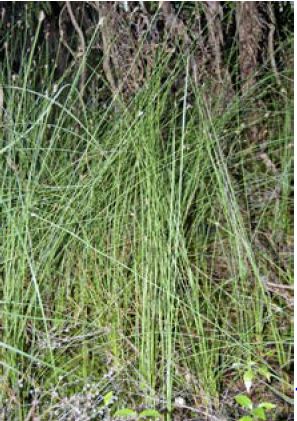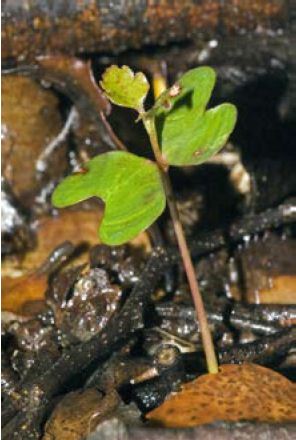Trip Report – 1 September 2012: Horoeka Street Scenic Reserve, Stokes Valley, Lower Hutt
 |
| Lepidosperma australe. Photo: Jeremy Rolfe. |
Fourteen members of BotSoc joined eleven members of the Friends of Horoeka Street Reserve to resurvey the vegetation in the reserve and adjoining bush. We formed three groups, each with a mix of BotSoccers and Friends, to survey three areas–a ridge, the main valley, and the bridle path. It was a very successful day with several plant species added to the list, including
Clematis forsteri,
Polystichum neozelandicum subsp.
zerophyllum,
Thelymitra sp. (?
hatchii),
Lepidothamnus australe,
Senecio minimus and
Gonocarpus aggregatus. A highlight on the ridge was
Griselinia littoralis which is uncommon in the area, probably because of the presence of deer. In the main valley we found the butterfly-shaped cotyledon leaves of germinating hard beech. Along the bridle path we found nine species of filmy fern, four species of tree fern, and swamp maire.
We added bellbird / korimako, tomtit / miromiro and NZ falcon / karearea, to the list. BotSoccers readily shared their knowledge and took time to explain to members of the Friends how to identify different plants, their Maori names and uses. At 3 p.m. we gathered at Tawhai School hall for refreshments and a debrief. We feasted on Patrick’s fabulous cheese scones. The Friends would like to thank BotSoccers for their efforts and for sharing their knowledge. We look forward to future collaboration.
Participants : BotSoc: David Allen, Sam Buckley, Barbara Clark, Sue Freitag, Anthony Hill, Chris Hopkins, Chris Horne, Rodney Lewington, Barbara Mitcalfe, Jeremy Rolfe, Darea Sherratt, John van den Hoeven, Irene Walshe, Carol West.
Friends : Pam Cromarty (leader / scribe), Kevin Eastwood, Bill Fensom, Paul Harris, Janet Hewson, Patrick Lanigan, Nicholas McPhee, Hana Stephen, Rachel Tallon, Sarah Tallon, Jemima Teal.
Background
 |
| The distinctive cotyledon leaves of a hard beech seedling. Photo: Jeremy Rolfe. |
The reserve, c. 23 ha, had been purchased from the Wellington Tenths Trust by Phil and Joy Waddington. They had a Queen Elizabeth II National Trust Open Space Covenant placed on c. 22 ha of the land. In 2011 they sold the property to Hutt City Council (HCC) with the intent that HCC make it a reserve. In December 2011 the land was gazetted as Scenic Reserve under section 19(1)(a) of the Reserves Act 1977. In 2001, Phil Waddington, Barbara Mitcalfe and Chris Horne did a botanical survey of the area. This information was an important part of the ecological case supporting HCC’s purchase of the land. There is a mosaic of vegetation types in the reserve, including kanuka (
Kunzea aff.
ericoides) forest and mixed forest dominated by black beech (
Nothofagus solandri var.
solandri), hard beech (
Nothofagus truncata), podocarps and kamahi (
Weinmannia racemosa). HCC own much of the adjoining land with native vegetation on it.
There is well-graded bridle path, believed to date back to 1863, beginning at the Horoeka St entrance that linked Stokes Valley and Mangaroa. It was used during the Land Wars, and was maintained and in regular use until the 1950s.
In January 2012, a Friends of Horoeka Street Reserve group (Friends) was formed, and in March 2012, the HCC and the Friends hosted an Opening Day attended by over 200 people. Most of the Friends are neighbouring land-owners, or local Stokes Valley residents.
The reserve has several small streams. In May 2012, David Moss, DOC, and some of the Friends, did a night-time spot-light survey of freshwater fish in the reserve. Species found were banded kokopu /
Galaxias fasciatus, including several possibly over 20 years old, and koura / freshwater crayfish /
Paranephrops planifrons. They also surveyed Tawhai Stream, and although the habitat in it appears to be better, only koura were found, suggesting that there is some barrier to fish passage.
Restoration planting is planned in parts of the reserve burnt in the 1950-60s, on an as-required basis, to hasten their recovery. HCC, which has an eco-sourcing policy, has provided 700 trees for this year’s planting, after close examination of the Friends’ request for plants, guided by Barbara and Chris’s 2001 plant list, and of the sites.
The Friends have been controlling rodents, mostly rats, but weasels, a stoat and possums have also been caught. Three trapping routes have been established, and these were the routes we used on our field trip. Phil Waddington had trapped in the area for years, and with the efforts of neighbours, and now the Friends’ group, trapping in the area over at least a decade should be having some impact. This year is considered to be a beech ‘mast’ year, because beech seeds are so abundant, so the numbers of pests trapped are much higher this year compared with the last two years, perhaps by as much as 300%.
Pam Cromarty, Trip Leader

 Site Index
Site Index







 Site Index
Site Index





